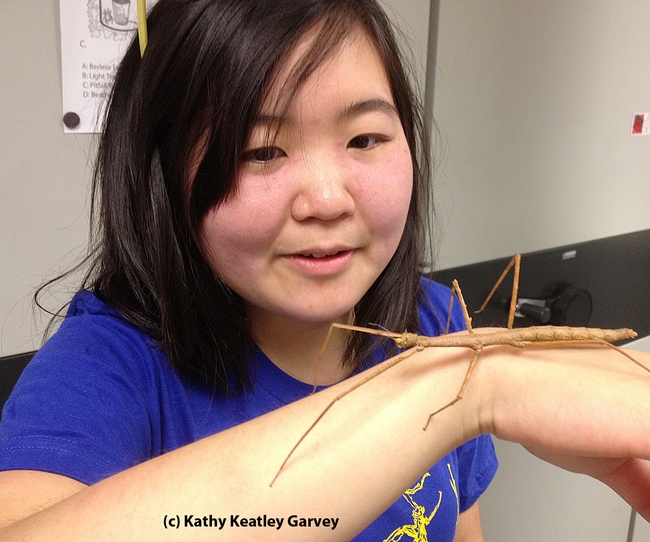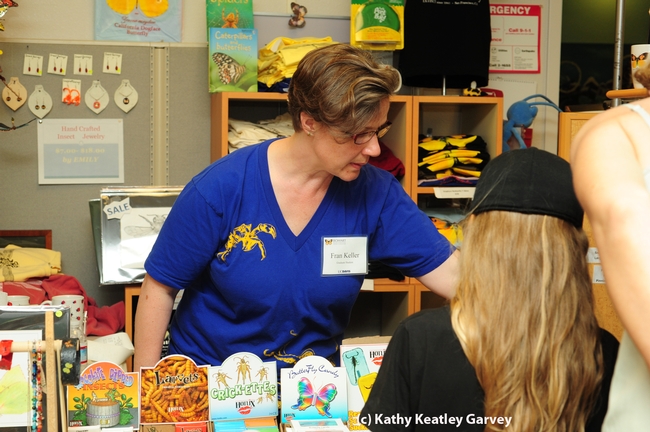- Author: Kathy Keatley Garvey
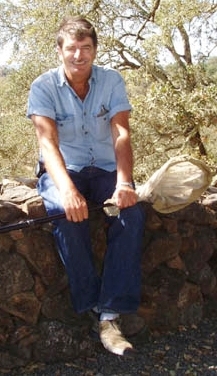
Umm, does California have a state insect? The Monarch? The Western Tiger Swallowtail? The Red Admiral? Wait, isn't this National Pollinator Week? Should I know what the state insect is?
Yes, it is National Pollinator Week. And yes, it's a good time to appreciate the state's designated insect--not just for "Insect of the Week" or "Insect of the Year" but for what it is--a fascinating but quite obscure butterfly that's rarely spotlighted.
That's why we were delighted to see the California dogface butterfly (Zerene eurydice) get some well-deserved attention when Capital Public Radio (CPR) headed off to Auburn last Friday to see the butterfly's major breeding ground. It's at a well hidden, publicly inaccessible site on Placer Land Trust.
The butterfly is also known as the California doghead butterfly and the flying pansy, referring to the male's black and yellow coloring. The female is mostly solid yellow.
Bohart Museum of Entomology associate Greg Kareofelas, a volunteer tour guide for the Placer Land Trust butterfly site for the past three years, is quoted in Bob Moffitt's CPR piece on "Placer County — A Popular Hideout For Rarely Seen Dogface Butterfly,” published last Sunday. Access http://www.capradio.org/articles/2016/06/19/placer-county-popular-hideout-for-rarely-seen-dogface-butterfly/
The butterfly is there because its larval host plant--false indigo (Amorpha californica)--is there. Justin Wages, land manager of the Placer Land Trust, which owns or manages 8,000 acres, says the plant is difficult to grow outside this habitat.

It was also a surprise to see so many dogface butterflies in the space of two hours last Friday. "It's a very good year when I see three dogface butterflies in a single year," Kareofelas said. "They're elusive and hard to see. Last Friday we saw about 10 females and 50 or 75 males."
Kareofelas knows butterflies and he knows the dogface butterfly. To say he's made major contributions to the understanding of the state insect would be an understatement. At his home in Davis, he's reared--and photographed--a dogface butterfly from egg to adult. He's grown the false indigo. His photographs of the female and male appear on a poster that he and entomologist Fran Keller created at the Bohart Museum. His images also appear in a 35-page children's book, "The Story of the Dogface Butterfly," written by Keller with illustrations by then UC Davis student Laine Bauer. Both the poster and the book are available for sale at the Bohart Museum, located in Room 1124 of the Academic Surge Building on the UC Davis campus. Net proceeds benefit the insect museum's education, outreach and research programs.
The book tells the untold story of the California dogface butterfly, and how schoolchildren became involved in convincing the State Legislature to select the colorful butterfly as the state insect. Bauer's illustrations depict the life cycle of this butterfly. As part of their research, Keller, Kareofelas and Bauer visited the Placer Land Trust habitat of the butterfly. And Kareofelas reared that elusive butterfly.
As for the book, “There are also ecology, life cycle, taxonomy and conservation issues presented that are relevant to grades K-6 that can be used in classroom curriculum,” Keller earlier told us. It also includes a glossary.
The butterfly, so named because of a poodle-like silhouette on the wings of the male, was adopted as the official California insect on July 28, 1972, but entomologists had selected it as the state insect as early as 1929. Their choice appears in the California Blue Book, published by the State Legislature in 1929. (Read more on how the butterfly became the state insect under the Ronald Reagan administration.)
Links:
Capital Public Radio Piece on Dogface Butterfly
Pacific Land Trust website
Bohart Museum of Entomology


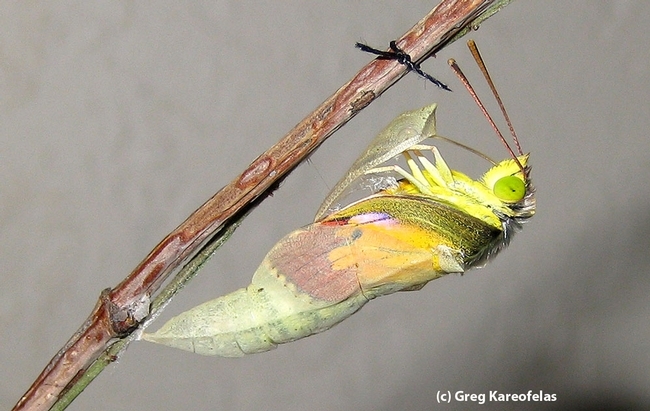
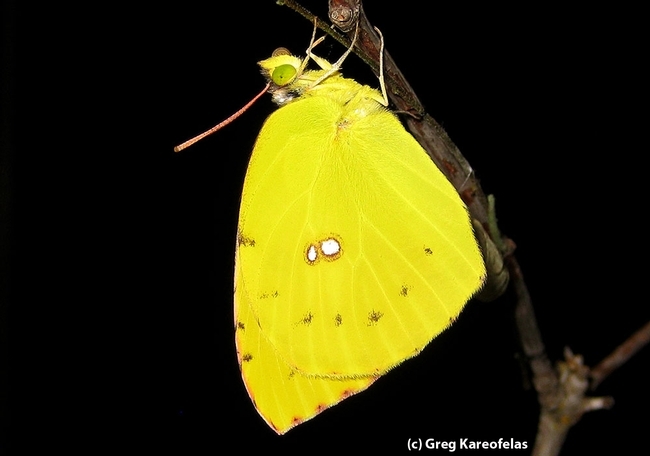
- Author: Kathy Keatley Garvey
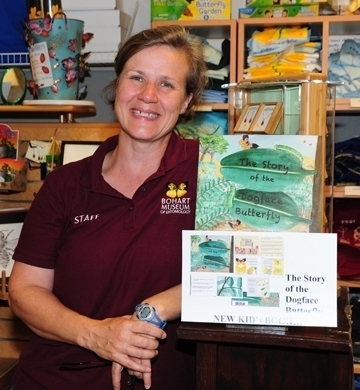
That's the theme of the Bohart Museum of Entomology open house from 1 to 4 p.m. on Saturday, Dec. 5 in Room 1124 of the Academic Surge Building on Crocker Lane, University of California, Davis.
In addition to the many exciting activities planned that day--it's free and open to the public--you can visit the museum's gift shop and find something “buggy” for holiday season for you or your family and friends. The gift shop is also open during the museum's regular hours, from 9 to noon and 1 to 5 p.m., Mondays through Thursdays.
Want a monarch butterfly t-shirt? Check.
Want some dragonfly earrings? Check.
Want some stocking stuffers, such as see-through lollipops with tasty crickets inside? Check.
Want an insect net for the budding entomologist in your family? Check.
Want some books on bees and bumblebees or a children's book on California's state insect, the dogface butterfly or a children's book on a butterfly found in the Amazon forest? Check.
Here are some of the items available at the Bohart Museum:
- Earrings and necklaces (with motifs of bees, dragonflies, moths, butterflies and other insects)
- T--shirts for babies, children and adults (walking sticks, monarch butterflies, beetles, dragonflies, dogface butterflies and the museum logo)
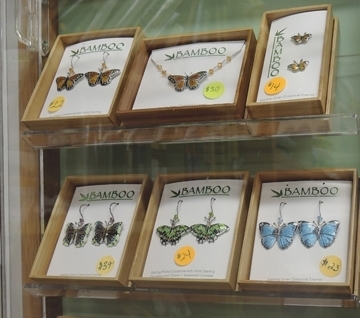 If you like jewelry with an insect motif, the Bohart Museum of Entomology can oblige. (Photo by Kathy Keatley Garvey)
If you like jewelry with an insect motif, the Bohart Museum of Entomology can oblige. (Photo by Kathy Keatley Garvey) - Insect candy (lollipops with either crickets and scorpions, and chocolate-covered scorpions)
- Insect-themed food, Chapul bars made with cricket flour, and flavored mealworms and crickets
- Insect collecting equipment: bug carriers, nets, pins, boxes, collecting kits
- Plastic insect toys and stuffed animals (mosquito, praying mantis, bed bug and others)
- Handmade redwood insect storage boxes by Bohart Museum associate Jeff Smith
- Posters (Central Valley butterflies, dragonflies of California, dogface butterfly), prints of selected museum specimens
- Books by museum-associated authors:
- The Story of the Dogface Butterfly (Fran Keller, Greg Kareofelas and Laine Bauer), Insects and Gardens Insects and Gardens: In Pursuit of a Garden Ecology (Eric Grissell), Bumble Bees of North America: An Identification Guide (co-authored by Robbin Thorp), California Bees and Blooms: A Guide for Gardeners and Naturalists (co-authored by Robbin Thorp), Guide to Butterflies of the San Francisco Bay and the Sacramento Region (Art Shapiro), Butterfly Wish (Steve Stoddard, pen name S.S. Dudley), and multiple dragonfly books by Kathy Biggs.
- Notecards of bees and other pollinators by yours truly and Mary Foley Benson's wasp and caterpillar art
- Bohart logos (youth t-shirts, stickers and patches
- Used books
- Gift memberships
- Naming of insect species in the biolegacy program
All proceeds go for a good cause--funding the operation of the Bohart Museum. Directed by Lynn Kimsey, professor of entomology at UC Davis, it houses nearly eight million insect specimens from throughout the world. Another popular attraction is the live "petting" zoo where you can hold and photograph Madagascar hissing cockroaches, walking sticks and a rose-haired tarantula named "Peaches."
Keep calm and insect on!
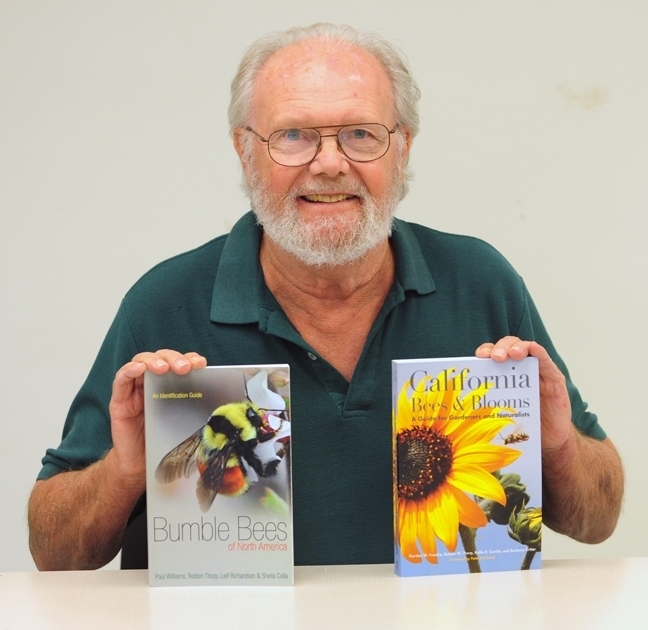
- Author: Kathy Keatley Garvey

Hint: It's the state insect.
"What, we have a state insect?" you ask.
Yes, and it's the California dogface butterfly (Zerene eurydice).
On the monorail, it's an artistic blue and white and it seems to flutter along for the ride. (See what the Monorail Society wrote about it in 1995.) In real life, the male of the species is yellow and black, and the female, predominantly yellow.
Fran Keller, doctoral candidate in entomology at the University of California, Davis, and her colleague, naturalist Greg Kareofelas of Davis, a volunteer at the Bohart Museum of Entomology identified the insect on the monorail right away. Several years ago they teamed to create a California dogface butterfly poster, which graces many a classroom, office, and den. The poster is for sale in the Bohart Museum's gift shop on Crocker Lane, UC Davis, or online.
Keller went on to write a children's book, "The Story of the Dogface Butterfly," with watercolor-and-ink illustrations by Laine Bauer, a 2012 graduate of UC Davis. Kareofelas contributed photographs.
Net proceeds from the sale of the 35-page book, also available at the Bohart Museum or online, benefit the insect museum's education, outreach and research programs.
The book tells the untold story of the California dogface butterfly, and how schoolchildren became involved in convincing the State Legislature to select the colorful butterfly as the state insect.
Bauer’s illustrations depict the life cycle of this butterfly. As part of their research, Keller, Karofelas and Bauer visited a Placer County habitat of the butterfly last year.
As for the book, “There are also ecology, life cycle, taxonomy and conservation issues presented that are relevant to grades K-6 that can be used in classroom curriculum,” Keller said. In addition, the book includes information on the butterfly’s host plant, false indigo (Amorpha californica).
So, score one for the California State Fair. And score two for the Bohart Museum.

- Author: Kathy Keatley Garvey
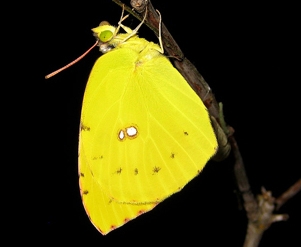
Now there's an opportunity for classrooms all across the nation--and butterfly fans--to learn about it in "The Story of the Dogface Butterfly," written by UC Davis doctoral candidate Fran Keller and illustrated (watercolor and ink) by Laine Bauer, a 2012 graduate of UC Davis.
Net proceeds from the sale of the 35-page book will benefit the education, outreach and research programs of the Bohart Museum of Entomology, UC Davis.
The book tells the untold story of the California dogface butterfly, Keller said, and how schoolchildren became involved in convincing the State Legislature to select the colorful butterfly as the state insect.
Bauer’s illustrations depict the life cycle of this butterfly. Naturalist Greg Kareofelas of Davis, a Bohart volunteer, contributed photos. As part of their research, the trio visited a Placer County habitat of the butterfly last year.
As for the book, “There are also ecology, life cycle, taxonomy and conservation issues presented that are relevant to grades K-6 that can be used in classroom curriculum,” Keller said. In addition, the book includes information on the butterfly’s host plant, false indigo (Amorpha californica).
“A glossary in the back highlights key terms,” Keller said. “And there is a set of photographs of the California dogface and another yellow butterfly to help you determine if you have ever really seen the California state insect.”
Some people confuse it with it the alfalfa butterfly.
You can meet the writer and illustrator at the Bohart Museum's open house on Saturday, Feb. 2 from 1 to 4 p.m. The museum is located at 1124 Academic Surge on Crocker Lane, UC Davis campus.
The book can also be ordered online from the Bohart website.
The museum's gift shop also has t-shirts and posters depicting the state insect.
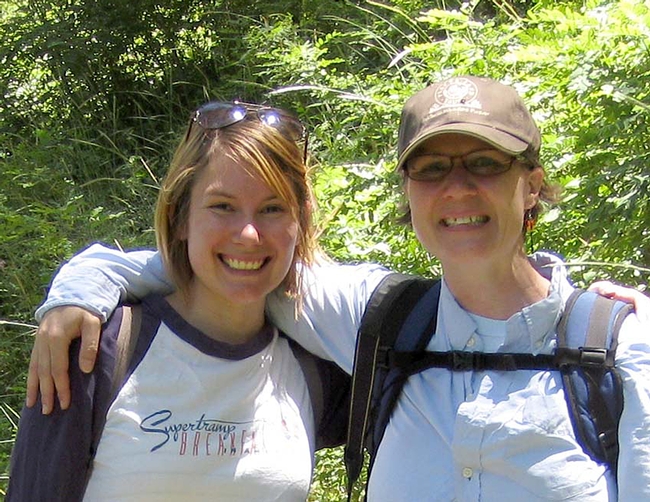
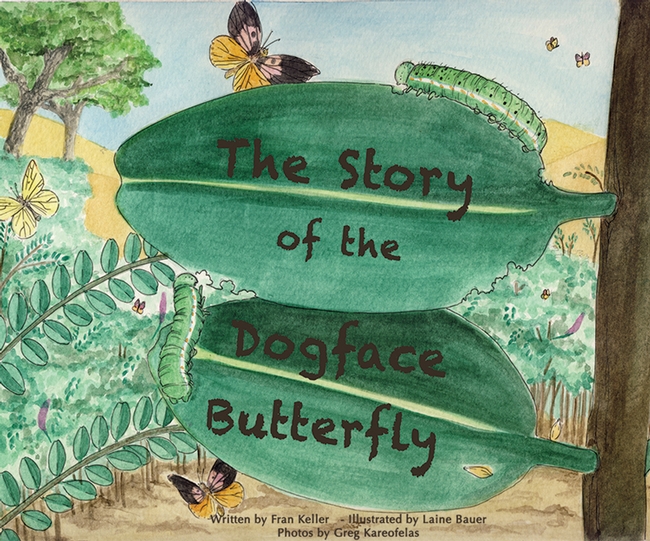
- Author: Kathy Keatley Garvey
If you or someone in a household near you can draw a bug, then you need to head over to the Bohart Museum of Entomology on the UC Davis campus on Saturday afternoon, Dec. 15.
The Bohart Museum is hosting an open house from 1 to 4 p.m. in Room 1124 Academic Surge on Crocker Lane. It's free and open to the public.
The theme: "Insects in Art."
The person (all ages invited) who submits the most creative bug drawing between 1 and 3:30 p.m. will win a t-shirt at around 4 p.m.
Here's what you do: draw a bug that will fit into a button about 2-1/4 wide. The Bohart Museum folks will insert it into their button-maker machine. If your bug art is selected as the most creative, you take the button home--and your prize, an insect-related t-shirt.
The open house will feature the illustrations of Lynn Kimsey, director of the Bohart and professor of entomology at UC Davis; the late Mary Foley Benson of Davis; and Ivana Li, an undergraduate entomology student and president of the UC Davis Entomology Club.
Visitors also will be able to see the original plates for the children’s book, “The Story of the Dogface Butterfly,” written by Fran Keller, doctoral candidate in entomology, and Laine Bauer, who received her degree in art in June from UC Davis. Greg Kareofelas of Davis, a Bohart volunteer, contributed photos.
Expanding on the open house theme, Heydon said that “Insects and Art” began as early as the caveman days. Cave drawings found in Spain depict honey gatherers from more than 10,000 years ago.
“Insects in art are found in scientific illustrations and are represented on fabric, paintings, toys, jewelry and other media,” Heydon said.
The Bohart Museum houses a global collection of nearly eight million insect specimens and is the seventh largest insect collection in North America. It is also the home of the California Insect Survey, a storehouse of the insect biodiversity. Noted entomologist Richard M. Bohart (1913-2007) founded the museum in 1946.
In addition to the insect specimens, the Bohart houses a “live petting zoo” of Madagascar hissing cockroaches, walking sticks and tarantulas; and a gift shop filled with t-shirts, sweatshirts, jewelry, posters, insect nets, and insect-themed candy.
Bohart officials schedule weekend open houses throughout the academic year so that families and others who cannot attend on the weekdays can do so on the weekends. The Bohart’s regular hours are from 9 a.m. to noon and from 1 to 5 p.m., Monday through Thursday. The insect museum is closed to the public on Fridays and on major holidays. Admission is free.
The remaining weekend open houses:
Sunday, Jan. 13, 1 to 4 p.m.
Theme: "Extreme Insects"
Saturday, Feb. 2, 1 to 4 p.m.
Theme: "Biodiversity Museum Day"
Sunday, March 24, 1 to 4 p.m.
Theme: "Aquatic Insects"
Saturday, April 20: 10 a.m. to 3 p.m.
Theme: UC Davis Picnic Day
Saturday, May 11, 1 to 4 p.m.
Theme: "Moth-er's Day"
Sunday, June 9, 1 to 4 p.m.
Theme: "How to Find Insects"
